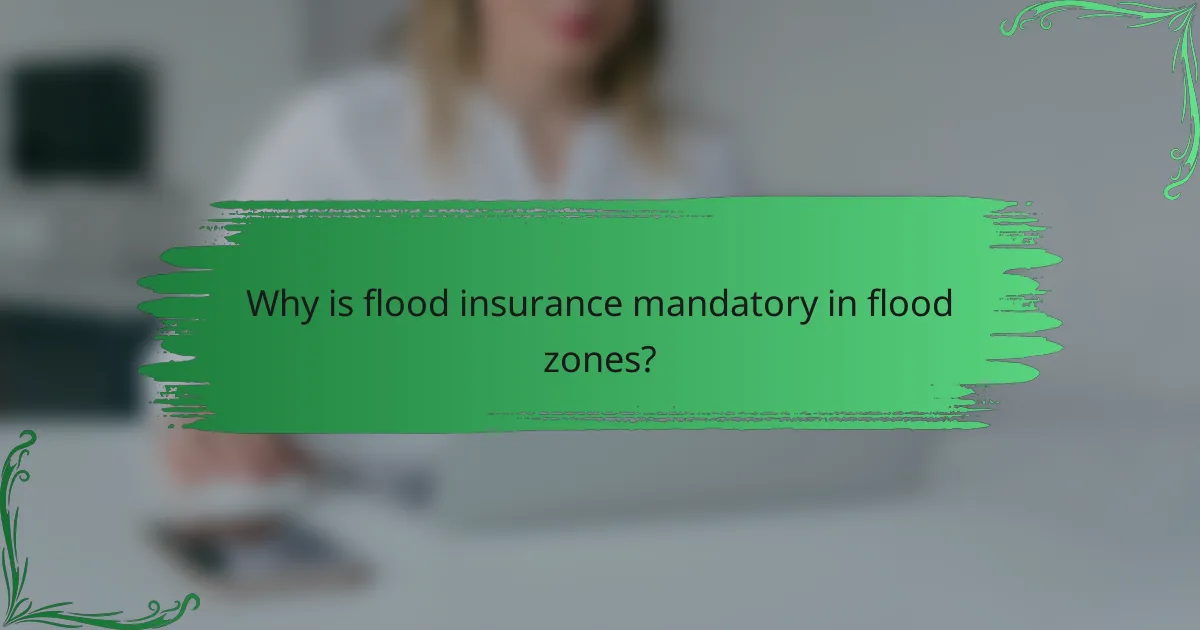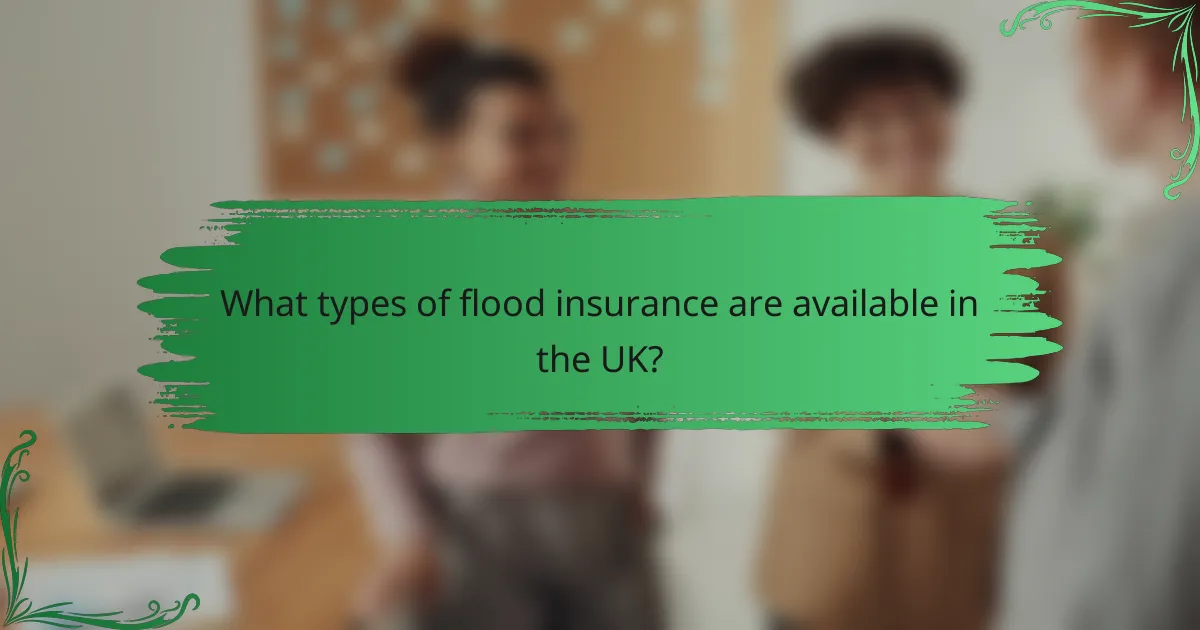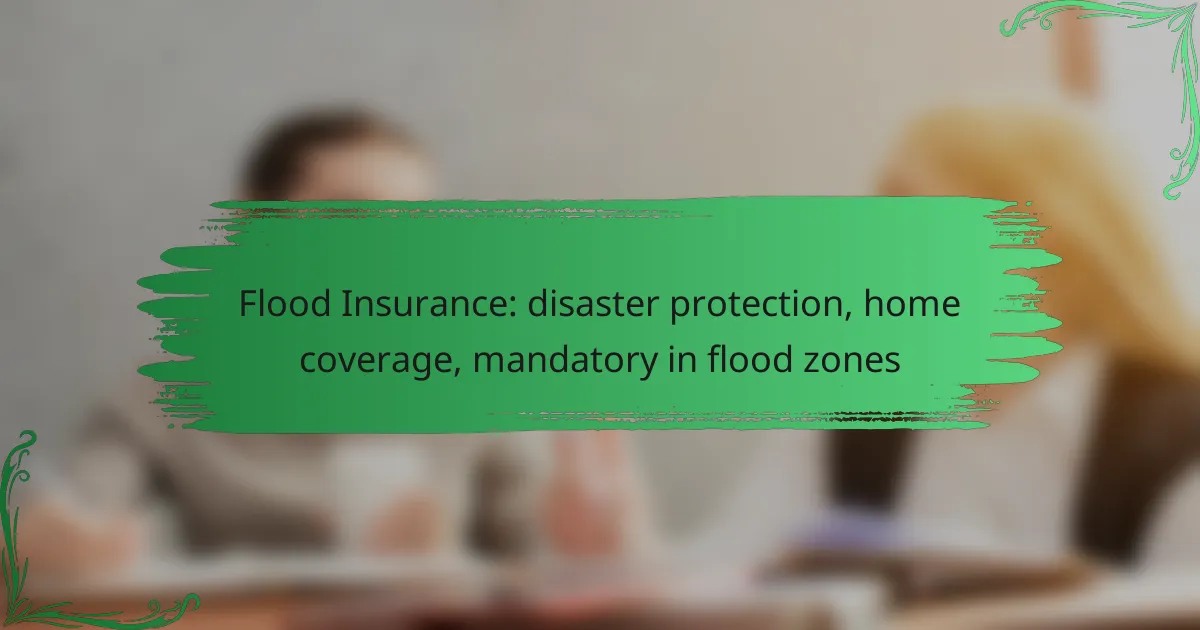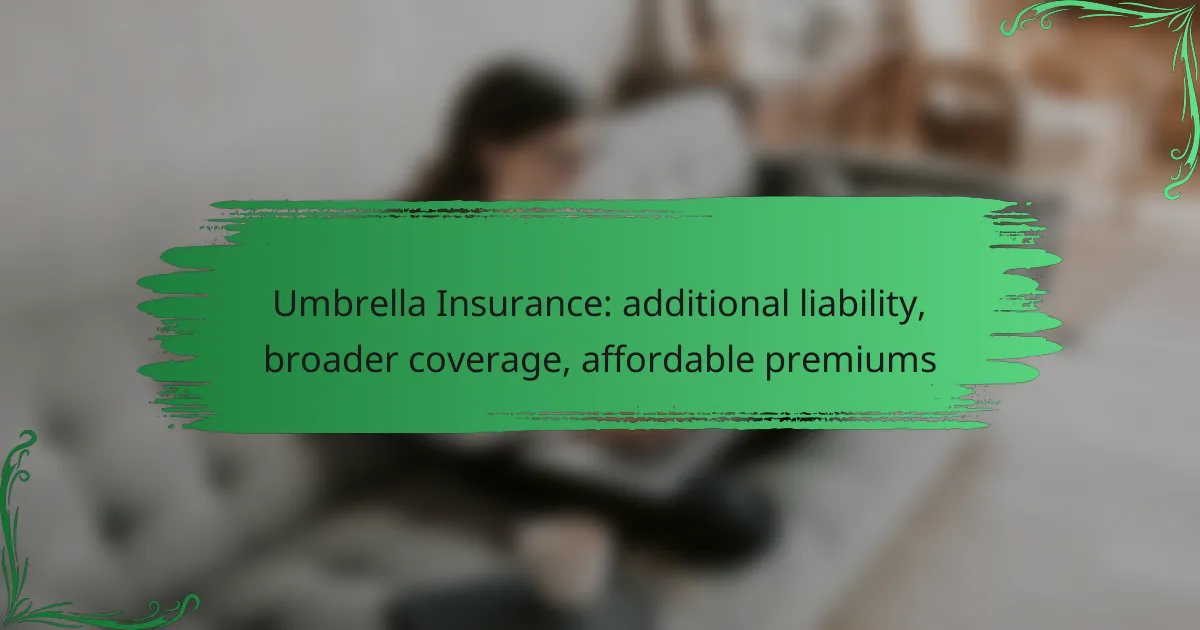Flood insurance is a crucial policy that offers financial protection against damages resulting from flooding, which is not typically covered by standard homeowners insurance. In flood-prone areas, this insurance is often mandatory, as lenders require it to safeguard properties and ensure homeowners are protected from potential financial losses due to flood events.

What is flood insurance?
Flood insurance is a specialized policy that provides financial protection against damages caused by flooding. It is essential for homeowners in flood-prone areas, as standard homeowners insurance typically does not cover flood-related losses.
Definition of flood insurance
Flood insurance is a type of property insurance designed to cover losses from flooding, which can result from heavy rainfall, storm surges, or melting snow. Policies are available through the National Flood Insurance Program (NFIP) in the United States, as well as private insurers.
This insurance typically covers the structure of the home and its contents, with specific limits on coverage amounts. Homeowners should review their policies to understand what is included and any exclusions that may apply.
Importance of flood insurance
Flood insurance is crucial for homeowners in designated flood zones, where the risk of flooding is significantly higher. Without this coverage, homeowners may face substantial financial losses, as federal disaster assistance may not fully cover damages.
In many cases, mortgage lenders require flood insurance for properties in high-risk areas. This requirement emphasizes the importance of securing a policy to protect both your investment and your financial stability.

Why is flood insurance mandatory in flood zones?
Flood insurance is mandatory in flood zones primarily to protect property owners from the financial devastation caused by flooding. In areas designated as high-risk, lenders often require homeowners to obtain this insurance to secure mortgages, ensuring that properties are safeguarded against potential flood damage.
Legal requirements in the UK
In the UK, flood insurance is not legally mandated for all homeowners; however, it is strongly recommended for those living in flood-prone areas. The Environment Agency provides flood risk assessments, and many mortgage lenders will require flood insurance as part of the lending process if the property is at significant risk. Homeowners should check their local flood risk maps to understand their obligations.
Additionally, the Flood Re scheme was established to make flood insurance more affordable for high-risk properties. This initiative allows insurers to offer policies at lower premiums, ensuring that homeowners can obtain necessary coverage.
Consequences of not having coverage
Not having flood insurance in flood zones can lead to severe financial repercussions. Homeowners may face substantial out-of-pocket expenses for repairs and rebuilding if their property is damaged by flooding. Without insurance, these costs can easily reach tens of thousands of pounds, depending on the extent of the damage.
Moreover, in cases where flood insurance is required by lenders, failing to secure coverage can result in the lender purchasing insurance on behalf of the homeowner at a much higher rate. This not only increases financial strain but also leaves the homeowner with limited options for recovery.

What types of flood insurance are available in the UK?
In the UK, flood insurance primarily includes standard policies and contents coverage options. These types of flood insurance are designed to protect homeowners and renters from the financial impact of flood damage.
Standard flood insurance policies
Standard flood insurance policies cover the structure of your home against flood damage. This includes damage to walls, floors, and the roof, as well as built-in fixtures like kitchens and bathrooms. Homeowners should ensure their policy meets the requirements set by the National Flood Insurance Program (NFIP) if applicable.
When selecting a policy, consider factors such as the level of coverage, excess amounts, and any exclusions. It’s advisable to compare quotes from multiple insurers to find the best deal that suits your needs.
Contents coverage options
Contents coverage options protect personal belongings within your home from flood damage. This includes furniture, electronics, clothing, and other valuables. Homeowners should assess the value of their possessions to determine the appropriate level of contents coverage needed.
Many insurers offer different tiers of contents coverage, ranging from basic to comprehensive. Be cautious of any limits on high-value items, and consider additional coverage for particularly valuable possessions. Regularly updating your inventory can help ensure you have adequate protection in place.

How to choose the right flood insurance policy?
Choosing the right flood insurance policy involves assessing your specific needs, understanding coverage options, and comparing different providers. It’s essential to evaluate the risks associated with your location and the value of your property to ensure adequate protection.
Factors to consider
When selecting a flood insurance policy, consider the coverage limits, deductibles, and the specific risks in your area. Policies typically cover structural damage and personal property, but you may need additional endorsements for high-value items.
Evaluate the National Flood Insurance Program (NFIP) guidelines, especially if you live in a designated flood zone, as certain regulations may require you to maintain flood insurance. Understanding the terms of your mortgage can also influence your policy choice.
Comparing different providers
When comparing flood insurance providers, look for their financial stability, customer service ratings, and claims processing efficiency. Check reviews and ratings from independent agencies to gauge their reliability.
Request quotes from multiple insurers to compare premiums and coverage options. Be mindful of the differences in deductibles and waiting periods, as these can significantly affect your out-of-pocket costs in the event of a flood.

What are the costs associated with flood insurance?
The costs associated with flood insurance can vary significantly based on several factors, including location, property value, and coverage limits. Homeowners in flood-prone areas often face higher premiums, which are essential for protecting their properties from potential flood damage.
Average premiums in flood-prone areas
In flood-prone areas, average premiums for flood insurance can range from a few hundred to several thousand dollars annually. For example, homeowners might pay between $600 and $1,200 per year, depending on the risk level of their specific location. Properties in high-risk zones may incur even higher costs, reflecting the increased likelihood of flooding.
Additionally, those with federally backed mortgages in designated flood zones are typically required to carry flood insurance, which can further influence average premium rates in these areas.
Factors affecting pricing
Several factors influence the pricing of flood insurance, including the property’s elevation, proximity to water bodies, and the building’s age and construction type. Homes built at a lower elevation or those located near rivers or coastlines generally face higher premiums due to increased flood risk.
Other considerations include the coverage amount selected and any additional endorsements or riders added to the policy. Homeowners should carefully assess their coverage needs and shop around for quotes to find the best rates.

How to file a flood insurance claim?
To file a flood insurance claim, contact your insurance provider as soon as possible after the flood event. Provide necessary documentation and details about the damage to expedite the claims process.
Steps to initiate a claim
Start by notifying your insurance company about the flood damage. Most insurers have a dedicated claims hotline or online portal for this purpose. Gather essential information, including your policy number, details of the incident, and a list of damaged items.
Next, document the damage thoroughly. Take clear photographs and videos of affected areas and belongings. This evidence will support your claim and help the adjuster assess the situation accurately.
Finally, complete any required claim forms provided by your insurer. Be sure to submit these forms along with your documentation promptly to avoid delays in processing your claim.
Common challenges in the claims process
One common challenge is the complexity of the claims paperwork. Many policyholders struggle with understanding the forms and documentation required, which can lead to incomplete submissions and delays. Consider seeking assistance from your insurance agent if needed.
Another issue is the potential for disputes over the valuation of damages. Insurance adjusters may assess damage differently than homeowners expect. To mitigate this, be prepared to negotiate and provide additional evidence if necessary.
Lastly, be aware of the timelines involved. Claims can take weeks or even months to process, especially during peak disaster recovery periods. Staying in regular contact with your insurer can help keep your claim moving forward.

What are the benefits of flood insurance?
Flood insurance provides crucial financial protection and peace of mind for homeowners, especially those in flood-prone areas. It helps cover the costs of damages caused by flooding, which standard homeowners insurance typically does not include.
Financial protection against damages
Flood insurance offers financial coverage for repairs and replacements of your home and belongings damaged by floodwaters. Policies can vary, but they often cover structural damage, personal property, and sometimes even temporary housing costs while repairs are made.
For example, a typical flood insurance policy may cover up to several hundred thousand dollars for structural damage, depending on the coverage limits you choose. Homeowners should assess their property value and potential flood risks to determine the appropriate coverage amount.
Peace of mind for homeowners
Having flood insurance can significantly reduce stress for homeowners living in flood-prone areas. Knowing that you have a safety net in place allows you to focus on recovery rather than worrying about the financial implications of flood damage.
Additionally, many lenders require flood insurance for properties located in designated flood zones. This requirement underscores the importance of having this coverage, as it not only protects your investment but also ensures compliance with lending regulations.

What are the limitations of flood insurance?
Flood insurance has several limitations that policyholders should be aware of. These include specific exclusions in coverage, limits on payouts, and waiting periods before claims can be made.
Exclusions in coverage
Flood insurance typically does not cover certain types of damage. For instance, damage caused by sewer backups or landslides is often excluded unless specific endorsements are added to the policy.
Additionally, personal property such as vehicles or outdoor structures may not be covered under standard flood insurance policies. Homeowners should review their policy details to understand what is and isn’t included.
It’s crucial to consider these exclusions when assessing your risk and determining the appropriate coverage. Consulting with an insurance agent can help clarify any uncertainties regarding coverage limits and exclusions.



